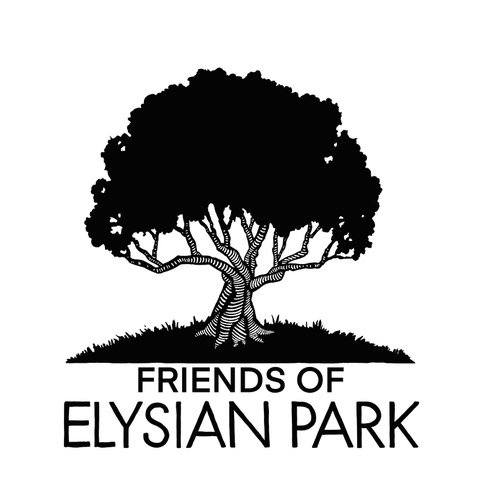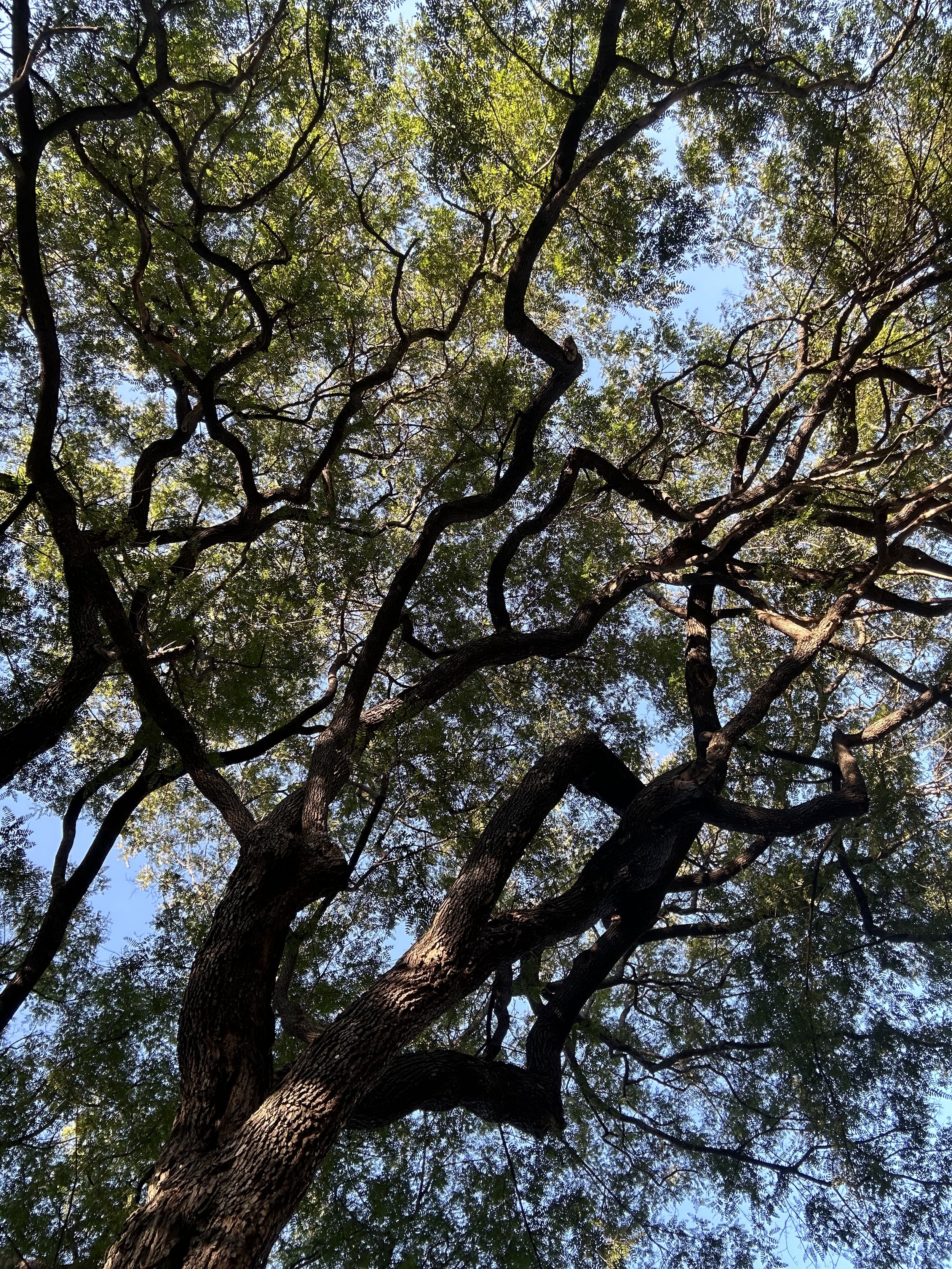For L.A.’s Original Arboretum, Accreditation Is a Century in the Making
Planted by community gardeners in 1893, the unique Chavez Ravine collection is seeking recognition as an official horticultural landmark.
By Erin SeditaPicnickers enjoy an evening in the Chavez Ravine Arboretum’s historic core.
As a runner who frequents the trails of Elysian Park, I have scouted every stride of level ground, every stretch of hard-won shade this challenging landscape has to offer. Early in my exploration, I learned that when the sun is high, the grassy grove that spans Stadium Way from the Grace E. Simons Lodge to the Avenue of the Palms is the best spot in the park to seek relief. Vaulted by towering trees, it is a haven of cool green in a place that, for much of the year, runs punishingly hot and dry.
It took me months to discover the reason for the area's relative lushness. One day, following my usual loop in the opposite direction, I noticed the weather-worn sign.
Bordered by a playground, two parking lots, and the park’s main road, the historic core of the Chavez Ravine Arboretum is a quietly awe-inspiring collection of native and exotic trees comprising 150 species from more than 50 countries, many planted before the turn of the twentieth century. Noted among its denizens are a giant sequoia, sacred fig, and what are thought to be the oldest and largest Cape chestnut, Queensland kauri, and tipa trees in the United States.
I know I’m not the only Elysian Park regular who has walked among this extraordinary set of trees and failed to take notice. With the recent effort by the L.A. Department of Recreation and Parks and Friends of Elysian Park to establish Chavez Ravine as an internationally accredited arboretum, advocates hope this horticultural gem will finally get its day in the sun.
Planting an Eden on “worthless” ground
In 1886, facing pressure to provide green space to its rapidly growing population, the Los Angeles City Council set aside 500 acres of rugged quarry land near the northwestern edge of town for the creation of Elysian Park. The project quickly won enthusiasm from local leaders who envisioned the space as a year-round oasis whose climate and natural setting would help it to outshine better-known East Coast venues.
Despite broad appetite among Angelenos for a new locus of civic pride, not everyone was optimistic that Elysian Park would be a worthwhile investment. Detractors warned that re-greening the park’s sun-baked hills and chiseled canyons without the aid of an extensive irrigation system was a waste of time and public funds. Some questioned whether trees and other large flora would be able to survive in the park even under artificial conditions.
From local roots, a global forest
For members of the Southern California Horticultural Society, there was never any doubt that trees would not just grow, but thrive in Elysian Park. Guided by conservationist ideals and a passion for forestry education, the group’s amateur arborists had been collecting rare specimens for decades with the hope of finding a place where seedlings from around the world could grow side by side. The new park, with ample space, sunshine, and weather to accommodate trees from a diverse range of habitats, turned out to be the perfect setting for Southern California’s first arboretum.
Postcard view of Elysian Park in the early 1900s, after 150,000 trees had been planted.
The Elysian Park Arboretum—later renamed to reflect its location within Chavez Ravine—was founded in 1893 with ten acres of parkland and a 4000-foot irrigation pipe provided by the city at a cost of just over $400. Over the next several decades, the fledgling collection amassed more than 500 specimens, planted and cared for by dedicated volunteers. Though the arboretum as a public attraction never achieved the prominence early proponents had hoped for, it stands today as a remarkable collection of rare and historic trees ripe for an era of rediscovery.
A new chapter for L.A.’s original arboreal wonder
In the lead-up to Elysian Park’s 140th anniversary in 2026, the L.A. Department of Recreation and Parks (RAP) has teamed up with community groups including the Friends of Elysian Park to revitalize the arboretum, affirming its status as one of the region’s foremost horticultural treasures. The effort will result in official recognition by ArbNet, an arboretum accreditation and networking program which has certified hundreds of collections around the world.
Accreditation, says RAP Principal Forester Leon Boroditsky, will be a game-changer for Chavez Ravine. The process has already acted as a catalyst for expanded investment, with staff working to fulfill ArbNet criteria for tree identification, land stewardship, and public outreach.
To earn ArbNet’s Level II designation, the arboretum must label a minimum of 100 tree taxa, establish a governance plan with paid staff for arboretum management, and commit to engaging the community through educational initiatives and annual events.
RAP Forester Leon Boroditsky works with a grad student volunteer to identify unknown taxa.
The effort to shore up species identification—a basic feature of any arboretum—has revealed new dimensions of the Chavez Ravine collection, surprising even those who know it best. During a recent walk-through by city foresters, dozens of trees were found to have been misidentified or never identified at all, especially among the palm, ficus, and eucalyptus groups. In several cases, RAP has had to consult expert arborists who have volunteered their time to help the collection reach the ArbNet benchmark of 100 accurately tagged species.
Consistently placed tree labels will represent a corrective to the spotty maintenance and record-keeping practices of the past. An essential aspect of visitor engagement, tags not only offer information to invested tree-lovers, but serve as a visual indicator of the collection’s significance to passers-by who might not otherwise stop to look.
“The tags we see on trees now tend to be of a different kind,” observes Boroditsky, referring to the graffiti that blights sporadic trunks along the park’s roads and trails. But, he emphasizes, vandalism and other maintenance challenges won’t discourage his department. Long-term planning for arboretum upkeep is not just a requirement for accreditation, but a driving ethos of RAP as it builds a space that Angelenos will enjoy for generations to come.
View of the arboretum and downtown skyline from the top of Palm Hill
For a place so rooted in history, the Chavez Ravine Arboretum has its sights set squarely on the future. Boroditsky says his team is focused on embedding the administrative practices necessary to ensure stewardship of the collection as the decades pass and the department turns over. As part of this approach, RAP staff are mapping a vision for climate adaptation that prioritizes the preservation of existing trees while considering how the arboretum might shift its stock toward heat-tolerant and drought-resistant species suited for a changing California.
Ultimately, champions of the arboretum envision a celebrated landmark that serves both as an everyday sanctum for nearby residents and a regional draw for L.A.’s nature-curious. Over the next five years, the arboretum will offer a growing slate of free, public events, including arborist-led tree walks and other interactive programming that uses natural history to connect people to the geographies and cultures that have shaped L.A.
For the self-guided visitor, Boroditsky’s department has plans for a QR code system that will prompt users to scan placards at each tree, connecting them to a website housing tree facts and collection history. Interactive signs will also be stationed at the neighboring playground, inviting young Angelenos to experience the magic that meets us when we remember to look up.
The sun sets over rare palm species on the arboretum’s historic Palm Hill.
Celebrating a century of citizen conservation
Now, 130 years after its historic founding, the Chavez Ravine Arboretum is closer than ever to embodying the Horticultural Society’s belief in the power of trees to teach, restore, and inspire. The endurance of the arboretum’s ten original acres through development, drought, and increasingly, the threats of a warming climate, serves as a potent symbol of L.A.’s natural resilience—and the legacy that civic stewardship can create.
It is notable, Boroditsky reminds us, that to the extent the arboretum has been managed over the past century, it has been with the considerable help of volunteers. From the horticulturalists who seeded its first trees to the city workers and community members powering the recent accreditation effort, this one-of-a-kind collection has been shepherded across the ages by ordinary citizens and delivered to us.
Boroditsky is confident that the arboretum's most influential chapter is yet to come. With the improved awareness, infrastructure, and engagement that accreditation brings, the Chavez Ravine collection will assume its rightful place in L.A. horticultural history.
“We’ve inherited all these trees—I feel responsible for them, responsible for passing along this gift that was given to us.”





